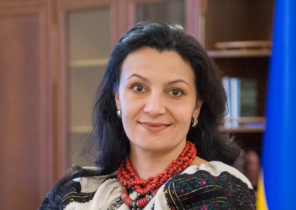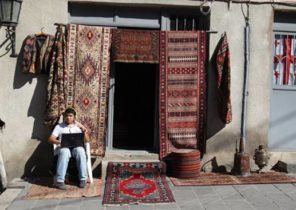Finnish culture has attracted the attention of the American researcher Timothy cook (Timothy J. Cook). He wants to understand what made the Finns. The answers the researcher, of course, looks in the “Kalevala”.
Having decided to write thesis about epics, Timothy cook year studied Finnish national epic at the University of Eastern Finland in academic year 2017/2018. Now a researcher writing a thesis at the American University of Nebraska-Lincoln. He considers the Finnish epic on a par with “the divine Comedy” by Dante, written in the fourteenth century.
Timothy cook shares four observations about the “Kalevala”. Researcher talks about whether the Finnish culture is built on stolen concepts.
Observation of the cook was commented by the Professor of folkloristics, University of Helsinki turkka of Lotte (Lotte Tarkka). She pointed out that these arguments are not new and remind that epos does not know state borders.
1) Kalevala was for the Finns a pass in the “big peoples”
When little people are waking up the desire to become independent, soon the question arises, how it can be done. In the nineteenth century in many parts of Europe began to think about how you can become something other than part of a large Empire. It would be possible to identify yourself with your tongue, place of residence and history, even to create their own small state.
“Many crave independence, but is it possible to gain? How to tell the world that we deserve independence?” — thinks of Timothy cook.
In the case of Finns, the answer was “Kalevala”, the first version of which Elias lönnrot (1802-1884) was published in 1835, second in 1849. The latest version of more and more famous. Since its publication it’s been 170 years.
Cook adheres to popular among researchers of “Kalevala” opinion: people need epic to define themselves and become visible. Requires quite significant in artistic terms the work in which it was highlighted would be the main features of the local culture and identity. After the appearance of this work is the presence of this group on the world stage cannot be denied.
“Finding the Kalevala, the Finns were able to refer to it and say that it’s their epic”.
Lotte Of Tarkka:
“Timothy cook is the views, which are widespread among researchers. “Kalevala” has become part of world literature and formed the basis of Finnish culture in the 1830-ies.
Now the researchers emphasize that the origin of this whole “project” can be considered European — the epic is based on the European written works and ideology of the time.
The feature of the “Kalevala” is that we sufficiently are “on the periphery”, thus the old tradition of runic songs has been able to successfully persist. The intelligentsia, in turn, were able to collect these songs in epic in the early nineteenth century. This “meeting” could happen only once — and she was very well documented in our archives.”
2) the birthplace of the Kalevala — Finland
Elias lönnrot collected the most significant elements of the Kalevala in Russian Karelia, mainly in the areas of Belomorskaya Karelia. The same themes and similar runic songs you can find in all the Baltic and Finnish peoples. For example, in Estonian culture can be found about half mythological elements of the Kalevala.
White sea Karelia was a place of intersection of many of the Karelo-Finnish cultures, and did runic songs are bright and versatile. This original features, and a new one created.
Timothy cook believes that Karelia was lönnrot — even when viewed from South of Finland, far away place, separated from the rest of the world in which you can find a link to the past.
Of course, no Karelia Finnish culture to be formed would not be able. Or, according to academician Anna-Lenna Siikala (1943-2016, Anna-Leena Siikala) in his work “the Mythology of the Baltic and Finnish peoples” (2012, Itämerensuomalaisten mytologia):
“Oral song, which has already become a living tradition and lost its mythical significance, has regained in the “Kalevala” mythological features to use the emerging state.”
Because Karelians did not write their history themselves, they could not imagine their world and therefore there are only in the subtext, writes researcher Timothy cook.
He says, if you can call “karelianism” lönnrot and other intellectuals who created the Finnish culture, a kind of colonialism. Or, to be more precise, cultural appropriation.
Karelianism called flourished in the late nineteenth century national-romantic enthusiasm for Karelia. The most ardent supporters of karelianism were artists, according to which the “Kalevala” reveals the essence of the ancient Finns.
“I’ve been thinking about the traits of colonialism in the attitude of Finns to Karelia. Can’t say that this was not, but it’s probably still an exaggeration. At least it’s not the whole truth,” says Timothy Cooke.
He believes that people everywhere and always borrowed each other’s legends and mythical characters.
The “väinämöinen belongs to no one. Literary hero nobody owns. The väinämöinen speaks to us from the face of Karelians and Finns”.
Lotte Of Tarkka:
“About the colonial nature of karelianism say in Finland since 1980-ies.
On the one hand, now in Russian Karelia has been considerable debate about whether to call the Kalevala “cultural theft”. On the other hand, in Russia, too, recognise the contribution of lönnrot, who makes an epic multinational.
The question is not about whether the “Kalevala” the Finnish or Karelian is a European national epics on the basis of the Finno-Karelian Runo song, which was created under the influence of European ideas of the Finnish poet-scholar.
In addition, runic folk songs, by their nature, belong to a culture that does not recognize nationalities or national boundaries.
When talking about cultural appropriation, it is about the political struggle for rights to the property. Cultural appropriation, that is, cultural appropriation, and the concept of “colonization of the traditions” should be limited only to those cases where traditions are being used in a foreign culture with the aim of obtaining economic benefits or subordination of other cultures. Otherwise, the assignment will be possible to call any interaction between cultures.
In relations between Finland and Russian Karelia were the stages that can be called cultural appropriation. For example, in the years of the continuation War (Soviet-Finnish war of 1941-1944), when Finland occupied the Western part of the white sea Karelia. Then the Kalevala was used as a propaganda work with the population and create a “greater Finland”. Materials officers involved in the education cause confusion.
Although Karelia was not epic themselves, I would not detract from their role. They sang runic songs and gave the Finns their record — without this basis for creating the culture and language would be very different. Some also collected the runic songs.
Then who owns the tradition? Quite often it is believed that in addition to the culture media (that is, rukopisi) also need collectors and archives, and only then we can talk about successfully documented tradition. And, of course, documentation should be based on mutual understanding.
In fact, many rune-singers was successfully agreed to receive royalties for their songs. They were not naive victims and understood the value of their cultural capital. However, they do not really understand what these songs will be on.”
3) On the old legends makes up the consciousness of the people
Timothy cook studied with interest the ancient epics. He says he keeps coming back to the question about their meaning. Until he decided on one answer: literature is one of the pillars of consciousness of the people. This is particularly clear in the myths and epics.
When man searches for himself, he needs external help — something that you can rely on. Cook believes that everyone wants to feel like a member of the group. A person has the need to be a part of something bigger, part of something common.
“While with the help of literature you can refer yourself to any group and form their identity, the importance of the old legends will not disappear”.
Although väinämöinen and the Odyssey are not historical figures, they still have a connection with the truth. People want to return to later legends of the century because they create the Foundation of personality.
In the legends of many forces. So Timothy cook believes it is important, how this power is used. For example, it is wrong to teach people biblical scenes. Although cook believes the manipulation of the treatments and the assignment of heroes is quite interesting processes, he refers to such phenomena with caution.
“In such cases, I’m looking for the original source. Then you can gently correct the wrong statements,” he says.
Lotte Of Tarkka:
“About the special role of epics and myths in the national consciousness write very many studies. However, the impact of heroes on epic consciousness of the people — the question is much more complex. Few people becomes “the Foundation of their identity” in Väinämöinen, or Aino Louhi.
The characters of the Kalevala can be called symbols, and the concentration of certain values, from which the modern people rather far. I have ten years of reading essays of students with a rating of “Kalevala”, and they are also to some extent move away from epic. That is, they do not consider characters of the epic heroes. Heroic they called only the mother of Lemminkäinen and Aino”.
4) How cool is that väinämöinen will be back!
“The old prophetic väinämöinen” — the man of letters and connoisseur of music, the sovereign and the bearded superstar “Kalevala”. At the end of the epic, väinämöinen still leaves behind his Kantele and songs. At parting he says:
“You’ll disappear this time
Days will pass and days will come
Again, I’m needed here,
To wait, to find me will be here
So I re-arranged Sampo,
Did the box polychord,
Again let the sky month
The sun again gave freedom:
After all, the month and the sun
The joy in the world is impossible.”
“This episode make me so happy. The main character needs to leave, but he warns that he will come back says that you’ll still be looking for me”.
Timothy cook believes that this moment connects the Kalevala today. Despite all progress and inventions make our lives easier, the world is still not perfect. Ancient epic still needed, including the Finns.
“Sometimes instead of something to Google, it is better to take in the old legends. There you will find the essence of everything”.
Cook väinämöinen calls the voice of the legends “these forest frontier areas”, the study of which will never go out of fashion.
Lotte Of Tarkka:
“Then I would agree with the researcher, although the tradition of “these forest frontier areas” is presented in a rather romantic light.
The väinämöinen was for the top of the head the personification of knowledge and intelligence. As such it appears in a national context, but a little differently. Forming the nation in the creation of the people wanted to dispel the primitive väinämöinen, so magic and witchcraft gave place to other qualities: his wisdom, leadership skills, song art.
It would be even better if the Finns are immersed in the study of those runic songs that lönnrot studied in the original — almost all of the runic songs that formed the basis of “Kalevala”, was published in “Old songs of the Finnish people”, which you can find on the Internet. (Suomen Kansan Vanhat Runot). In 2020, should appear in the digital version of the Kalevala with explanations and references to these runic songs in Finnish.
I believe that the connection between the past and the future in the described lendrum the return of väinämöinen is rarely perceived as relevant the relationship between “Kalevala” and our time. I think that it is better to search in the language. Especially in the language of oral folk runic songs, which in comparison with the language collected, the Kalevala seems incredibly beautiful and strong.”







